List of political parties in Werania
Jump to navigation
Jump to search
This article lists political parties in Werania.
Parties with federal representation
| Party logo | Party name | Leader | Volkstag seats | Herrstag seats | Seats in state governments |
Euclean Parliament seats |
Ideology | |
|---|---|---|---|---|---|---|---|---|

|
National Consolidation Party Nationale Konsolidierungspartei |
 Otto von Hößlin |
244 / 545
|
130 / 232
|
314 / 1,067
|
47 / 121
|
||
| The NKP was founded in 1957 as a merger of the Conservative Party, National Liberal Party and the Catholic Social Party in order to create a big-tent party of the right. The NKP held government several times in the 20th century promoting centre-right and Sotirian democratic policies. It was in opposition from 1984 to 1999 before coming back to power under Rasa Šimonytė, the first Ruttish and female Chancellor who oversaw the Weranian response to the Great Recession. The party came back to power in 2019 under Otto von Hößlin who has supported a more national conservative and euclesceptic position. | ||||||||
| Social Democratic Radical Party of Werania Sozialdemokratische Radikale Partei von Ostischland |
 Luise Höcherl |
85 / 545
|
59 / 232
|
198 / 1,067
|
19 / 121
|
|||
| A merger of the Social Democratic Party of Werania and the Radical Party in 1977 the SRPO was intended to serve as a centre-left counterpart to the NKP in order to facilitate the creation of a two-party system. The SRPO first came to power in 1984 under Ludolf Ostermann who would become Werania's longest serving Chancellor in 100 years. Initially aligned with the socialist OSAI the party embraced third way politics during the 1980's overseeing economic liberalisation. The party lost power in 1999 entering government again in 2011 in a coalition with liberal parties. In 2019 the party suffered its worst result in its history. | ||||||||

|
Greens - Ecological Action Grünen - Ökologische Aktion |
  Yvonne Buchholz & Josef Kirui |
80 / 545
|
9 / 232
|
174 / 1,067
|
22 / 121
|
||
| Founded in 1977, the Greens has been represented in the Weranian Bundestag since 1987 following increased awareness of environmental issues. The Greens have risen in terms of support since the 2005 recession due to their progressive politics. They served in the federal goverment from 1995 to 1999. The Green party became the third largest political force in the 2019 elections attaining roughly the same support as the SRPO. | ||||||||

|
Modern Centre Party Partei des Modernen Zentrums |
  Edmund Remarque & Anna Nehammer |
32 / 545
|
7 / 232
|
123 / 1,067
|
8 / 121
|
||
| The Modern Centre Party was founded in 1972 following the student protests that year by a group of student activists and intellectuals who espoused a common programme of radicalism, liberalism and political reform. The PMZ entered government in 1983 with the SRPO where they promoted economic and social liberalism, going into opposition in 1999. They reformed a coalition government with the SRPO in 2011 as the junior partner where they pushed through austerity policies to reduce public expenditure. The PMZ lost power alongside the SRPO in 2019. They tend to be the most pro-Euclean of all the Weranic parties being in favour of a federal Euclea. | ||||||||

|
Democratic Alternative Demokratische Alternative |
 Käthe Schickdanze |
30 / 545
|
2 / 232
|
46 / 1,067
|
8 / 121
|
||
| The Democratic Alternative was formed in 1985 by right-wing members of the National Consolidation Party dissatisfied with the party leadership. The DA contains a mixture of national conservatives, national liberals, libertarians and populists but is broadly united by a strong souverainiste policy towards the Euclean Community, supporting an exit from the organisation. The DA since 2019 serves in the federal government as the junior partner to the NKP. | ||||||||

|
National Coalition for Independence Nacionalinė Nepriklausomybės Koalicija |
 Arvydas Ražauskas |
31 / 545
|
10 / 232
|
70 / 1,067
|
4 / 121
|
||
| A party that exclusively runs in Ruttland, the NNK was formed in 1999 by businessmen Arvydas Ražauskas. Its main position is the establishment of an independent Ruttish republic and is considered the main separatist party in the free state. On other policies it is considered populist supporting a broadly progressive economic policy coupled with conservative social policies and strong environmentalist positions. It formed the Ruttish regional government from 2008-2012 and since 2019 is the biggest party in Ruttland. | ||||||||

|
Weranic Section of the Workers' International Ostisch Sektion der Arbeiter Internationale |
 Peter Lötzsch |
22 / 545
|
6 / 232
|
62 / 1,067
|
8 / 121
|
||
| The oldest party in Werania, the OSAI during the first half of the 20th century was one of the major socialist parties in Euclea being supportive of orthodox socialism, albeit representing a more reformist path then Swetanian and Marolev socialists. It declined following the emergence of the SRPO and the Green parties with changes in the structures of the economy seeing a general decline in union based labour the OSAI relied on for its support base. It is still close to the General Federation of Weranic Workers' (ABOA), the second largest federation of trade unions in Werania. | ||||||||

|
Sotirian Democratic Homeland Sotričionių Demokratų Tėvynė |
 Natalija Saldaitiene |
9 / 545
|
4 / 232
|
16 / 1,067
|
1 / 121
|
||
| Formed in 1937 in order to counter left-wing parties in Ruttland, the SDT runs solely in Ruttland. Founded with close connections to the Ruttish clergy throughout the latter half of the 20th century it established itself as the largest party in Ruttland alongside the Social Democratic Party-Labour Union (the SRPO's branch in Ruttland) and the NKP. It also served in federal governments from 1999-2011 and 2015-2019 and provided parliamentary support for governments from 1963-1972. Although formed as an ultraconservative party the SDT has since been seen as a pragmatic force serving in coalition with conservatives, liberals and socialists. | ||||||||

|
Weranic Völkisch Freedom Party Ostisch Völkische Freiheitspartei |
 Albrecht Ströher |
9 / 545
|
0 / 232
|
20 / 1,067
|
3 / 121
|
||
| A far-right party, the OVFP are the modern forebearers of the Völkisch movement which has roots in the pre-unification states of Werania. They were formed in 2005 as a response to the Euclean financial crisis being led by Albrecht Ströher becoming briefly the fifth largest party in 2007 but have declined since. The OVFP are the only party that supports the unification of all Weranic lands, specifically Cisvetania in Swetania. | ||||||||

|
Aldman People's Party Aldske Folkspartij |
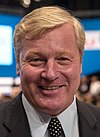 Haiko Posthuma |
2 / 545
|
0 / 232
|
10 / 1,067
|
1 / 121
|
| |
| Being representative of the Aldman community, the AFP mainly is concentrated on the Estmerish border in Cislania. A centrist party that is broadly liberal and pro-Euclean, the AFP often serves as a coalition partner for the Cislanian government due to its ideology flexibility. | ||||||||
| United Party Vereinigte Partei Vaega Faaupufai Aufaatasi |
 Matthias Iha |
1 / 545
|
0 / 232
|
13 / 1,067
|
0 / 121
|
|||
| Formed in 1950 the United Party is the largest party in Charlotte Island. It mainly promotes unionism with Werania and Charlotte Island, with most of its other policies being centre-right in nature. It supports the National Consolidation Party on a national level sitting in their parliamentary group. | ||||||||
Minor parties
| Party logo | Party name | Leader | Seats in state governments |
Ideology | |||
|---|---|---|---|---|---|---|---|

|
Democratic Party Vaega Faaupufai Temokalasi Demokratische Partei |
 Iareto Ala'ilima |
7 / 1,067
|
||||
| The VFT-DP was founded in 1992 when Iareto Ala'ilima split from the TFS after opposing the latters land reform policies. The VFT-DP is supported by the traditional tribal chiefs on the island and supports conservative policies that is more accommodating of the rural Tutuan population in contrast to the Lapaha based United Party and Reform Alliance. | |||||||

|
Reform Alliance Toe Fuata'iga So'otaga Reformbündnis |
 Opetaia Lotomau |
3 / 1,067
|
||||
| The Reform Alliance was founded in the 1980's as a merger of ethnic minority groups opposed to the minority rule of the United Party. Primarily supported by labourers in Lapaha the Reform Alliance is supported by a mixture of Tutuan and Coian people. They are supportive of Charlotte Islander independence and socialist economics. | |||||||
| Women of Werania Frauen aus Ostischland |
 Patrizia Auffarth |
0 / 1,067
|
|||||
| Future Party Zukünftige |
 Gunnar Breytenbach |
0 / 1,067
|
|||||

|
Fur not feathers Party Pelz statt Federn Partei |
 Adalbert II |
0 / 1,067
|
||||
Defunct parties
| Party logo | Party name | First leader | Last leader | Establishment | Dissolution | Ideology | |
|---|---|---|---|---|---|---|---|
| Leftist Bloc Linker Block |
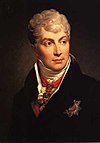 Ulrich von Bayrhoffer |
 Helmut von Mayenburg |
1842 | 1898 | |||
| A loose political grouping rather then a coherent political party, the Leftist Bloc tended to represent the liberal wing of Weranian politics. They were strong under Ulrich von Bayrhoffer who supported a form of liberal nationalism that would unite the Weranic lands - however following the War of the Triple Alliance the Leftist Bloc declined due to the upsurge of conservatism. The Leftist Block would also be threatened by the far-left that morphed into the socialist movement. The Leftist Bloc collapsed when its majority wing formed the Radical Party and its minority wing the National Liberals. | |||||||
| Rightist Bloc Rechter Block |
 Ferdinand Karl von Schillingsfürst |
 Konrad von Höhnel |
1842 | 1898 | |||
| A loose political grouping rather then a coherent political party, the Rightist Bloc tended to represent the conservative wing of Weranian politics. The Rightist Bloc increased in strength during the mid 19th century. The bloc was divided between more absolutist and more liberal factions that meant despite its dominance in the Bundestag it often was not an effective political bloc. As a whole it tended to oppose social reforms and support bureaucratic control. The bloc split into two organised political parties in 1900 - the National Liberals and Conservatives. | |||||||
| Republican Bloc Republikanischer Block |
 Klemens Müller |
 Vincent Mayrhofer |
1842 | 1910 | |||
| A loose political grouping rather then a coherent political party, the Republicans were those who supported the reestablishment of a Weranian republic and were mainly made up of members of the Septemberists. A failed Septemberist uprising led to a collapse of the republican movement in 1856, leading to the republican bloc in the Bundestag to be marginalised. The rise of socialist parties in the 1880's saw the Republicans beginning to include them under their parliamentary bloc. In 1898 the majority of republicans joined the new radical party and in 1911 the remaining parliamentary delegates joined the radicals. | |||||||
| Weranian Socialist Party Ostischersozialistische Partei |
 Ludwig Vollmar |
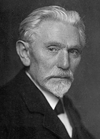 Albrecht Küchenthal |
1872 | 1901 | |||
| The first Weranian socialist party, the OSP was created by the esteemed scholar Ludwig Vollmar. The OSP contained a variety of political opinions but tended to be more revolutionary then other socialist parties, supporting both scientific socialism and syndicalism. It was commonly accused of impossibilism by its opponents. The OSP joined with the Weranian Socialist Workers' Party in 1901 to form the Weranic Section of the Workers' International. | |||||||
| Young Ruttland Party Jaunoji Ruttųijos Partija |
 Kasimieras Kiaupienė |
 Arvydas Żyliński |
1876 | 1930 | |||
| The JRP was formed in 1876 following the failure of Chancellor Franz Gustav von Reichenstein to extend home rule to Ruttland. Comprised primarily of Ruttish intellectuals the JRP was part of a general movement that revived the Ruttish language and cultural aspects, being firmly rooted in liberal assumptions. The JRP pushed for home rule albeit factions within it favoured outright independence. The JRP was dissolved in 1930 during the Great War after the Weranic government feared it would side with the Gaullican-backed Ruttish Republic. | |||||||
| Weranian Socialist Workers' Party Ostischersozialistische Arbeiterpartei |
 Joachim Heisenberg |
1890 | 1901 | ||||
| The OSAP was formed in 1890 by Joachim Heisenberg in opposition to the OSP's "impossibilism" with Heisenberg promoting a more gradualist course for socialist politics and cooperation with bourgeois parties. The OSAP merged with the OSP in 1901 into the Weranic Section of the Workers' International. | |||||||

|
Radical Party Radikale Partei |
 Lothar von Kuehnelt |
 Joschka Schreiber |
1898 | 1977 | ||
| The radical party was founded as the first organised political party in Werania representing radicals, liberals and republicans. The party led progressive governments from 1903-8 and 1911-13 but lost its pre-eminent position on the left after the rise of the socialist OSAI party due to the Great Collapse. The RP was a member of the popular front government of 1915-1918 but soon began to participate in various centre-left, centrist and right-wing governments. The foundation of the PMZ in the 1970's led to the radicals to decline in support and merge with the social democrats to form the SRPO in 1977. | |||||||
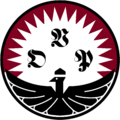
|
Weranian Conservative Party Ostischer Konservative Partei |
 Konrad Graf von Köfering zu Henßler |
 Walther Ritter von Dittmann |
1898 | 1957 | ||
| The OKP was formed from former members of the Right Bloc who supported a strong role for the monarchy. From its creation the OKP was marginalised as the Catholic Social Party became the main right-wing force. The party participated in several cabinets most notoriously when its leader Hermann von Ratzinger promoted authoritarian policies. Having strong support from dietsmen from the colonies the OKP led the governments during the 1940's when they implemented authoritarian policies. The OKP's extreme anti-socialism led to a worsening of relations with Kirenia and eventually the start of the Kirenian-Weranian War. The loss of that war led to the ousting of the OKP dominated government and they became ostracised from government, suffering a steep decline as a result.They merged into the NKP in 1957. | |||||||

|
National Liberal Party Nationalliberale Partei |
 Konrad von Höhnel |
 Gottfried von Litzmann |
1898 | 1957 | ||
| Founded by former members of the right and left blocs, the national liberal party was a core component of centrist and right-wing coalitions in the early 20th century. The NLP often represented moderate conservatives and liberals alike, although due to the rise of socialism and the decline of the radical party steadily moved to the centre-right throughout its existence. Like the OKP and KSP it was discredited by colonial wars and in 1957 merged into the NKP. | |||||||

|
Catholic Social Party Katholische Soziale Partei |
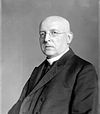 Erich Schätzle |
 Konstantin Vogel |
1900 | 1957 | ||
| Founded by the Mayor of Wiesstadt Gustav de Maizière the KSP soon competed with the OSAI as the largest party of Werania gaining strong support from the Catholic church. A largely centrist party the KSP was a part of every government from 1914 to its dissolution in 1957 aside from the 1918-1922 Popular Front government becoming a pragmatic force with little fixed ideology. A strong supporter of a social market economy the KSP under its leader Konstantin Vogel was the main party to push for the creation of the NKP in 1957. | |||||||
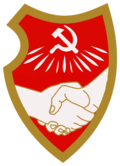
|
Social Democratic Party of Werania Sozialdemokratische Partei Ostischland |
 Gustav Kroetz |
 Ludolf Ostermann |
1919 | 1977 | ||
| The SPO were founded in 1919 as the pro-war wing of the OSAI party that supported conflict with Swetania which the OSAI government had opposed. Although founded "supporting the revolutionary proletariat" the SPO soon moved to the right adopting a revisionist and reformist line. During the 1950's it formed the grand coalition between the OSAI and KSP before largely aligning with the OSAI and RP against the NKP. In 1977 it decided to merge with the RP to form the SRPO. | |||||||

|
Weranic Syndicalist Union Ostischer Syndikalistische Union |
 Siegfried Höcker |
1914 | 1922 | |||
| The OSU was created in 1914 after nationalist members of the OSAI were expelled for opposing a Popular Front strategy. Centred around Siegfried Höcker the OSU began to support national syndicalism, neo-socialism and a form of neo-Caciarellism that called for a small vanguard to secure a proletarian revolution. The OSU steadily moved to the right with some of its members joining the NVB but continued to be a marginal player in Weranic politics. It was dissolved in 1922 by the Weranic government after Höcker attempted a putsch against the Weranian government. | |||||||

|
National Völkisch Movement Nationale Völkische Bewegung |
 August Vorbeck |
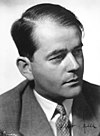 Wilhelm von Friedeburg |
1920 | 1933 | ||
| The NVB was created predominantly by a collection of national syndicalists from the OSU, former members of the conservatives and radicals within the OB. A quasi-functionalist party based around its leader August Vorbeck the NVB came first in the 1924 but failed to form government. During the Great War the NVB allied with Gaullica with 1927 creating the Volkhöfen Government which collaborated with Gaullica. The creation of the Ruttish Republic and continued demands for a "greater Werania" led to tensions between Vorbeck and Gaullica with Vorbeck being killed in 1930. In 1933 the NVB and Volkhöfen Government was dissolved by Gaullica with its cadres executed. | |||||||
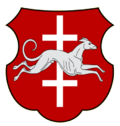
|
National Resurrection Party Tautos Prisikėlimo Partija |
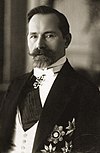 Zydrunas Biržiška |
1920 | 1934 |
| ||
| The TPP was created by a coalition of Ruttish nationalists in 1920 with its leader Zydrunas Biržiška splitting from the YTP. Although initially a national conservative party following the invasion of Werania during the Great War the party aligned with Gaullica and played a major role in the creation of the Ruttish Republic. The TPP soon modelled on Gaullica's Popular Party adopting functionalism and corporate statism mixing it with strident Ruttish nationalism that was anti-Weranian in character. The RS was dissolved in 1934 with the fall of the Ruttish Republic and the execution of Biržiška by partisans. | |||||||

|
Catholic Labour Union Katholischer Arbeiterverband |
 Rainier Meißner |
 Ewald Geist |
1957 | 1977 | ||
| The KAB was formed from the left-wing of the KSP which refused to merge into the NKP. A Sotirian left party they generally worked with the social democrats in the Bundestag although at times cooperated with the governing party on social issues. In 1977 they merged into the SRPO. | |||||||

